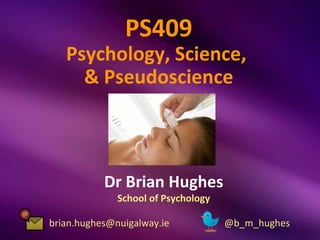
Psychology, Science, and Pseudoscience: Class #13 (Telepathy, Psychokinesis)
- 1. PS409 Psychology, Science, & Pseudoscience Dr Brian Hughes School of Psychology brian.hughes@nuigalway.ie @b_m_hughes
- 2. Case Studies: Examples of Psychology-related Pseudoscience
- 3. Case Studies from Outside Mainstream Psychology: 2. Telepathy and psychokinesis
- 4. “Psi” phenomena Thouless (1942), after Wiesner: Psi = the psychic force thought to be manifested by the paranormal phenomena that comprise the subject matter of parapsychology
- 5. “Psi” phenomena Thouless (1942), after Wiesner: Psi = the psychic force thought to be manifested by the paranormal phenomena that comprise the subject matter of parapsychology Generally refers to interaction between the private mind and the public world World Mind: Extrasensory perception (ESP) Telepathy Clairvoyance Precognition Mind World: Psychokinesis (PK)
- 6. Extrasensory Perception (ESP) e.g., Ganzfeld (“total field)” experiments Bem & Honorton (1994) 35% “hit” rate (vs. expected rate = 25%) p = .002 Milton & Wiseman (1999) Failure to replicate Identified statistical error in Bem & Honorton’s analysis
- 7. Extrasensory Perception (ESP) e.g., Ganzfeld (“total field)” experiments Debates over evidence Replication problem No reliably replicable demonstration exists “Gifted” researchers? Effect sizes Inadequate controls Sensory leakage Randomization File-drawer problem
- 8. Psychokinesis (PK) Late 19th century: non-experimental research Anecdotal reports on séances Case studies, field investigations, etc. William James (1896)
- 9. Psychokinesis (PK) Late 19th century: non-experimental research Anecdotal reports on séances Case studies, field investigations, etc. William James (1896) 1920s onwards: experimental research e.g., Rhine (1927), Duke University Dice-throwing studies, of increasing sophistication Dice-throwing machines Photographing of throw outcomes Corrections for weight unevenness Girden (1962) Sophistication reduces effect size to non-significance
- 10. PK dice studies Radin & Ferrari (1991) meta-analysis 148 studies from 1935 to 1987 2,569 participants; 2,592,817 dice throws Small, but statistically significant, overall effect Effect size moderated by methodological features: Effect size statistic (π)* All studies (148) .50610 All studies, weighting for quality (148) .50362 Studies controlling for dice-weight unevenness (69) .50431 Studies controlling for weight and statistical homogeneity (59) .50158 Studies controlling for weight, homogeneity, and quality (59) .50147 *As computed by Bösch et al. (2006); π = .50 indicates chance levels
- 11. PK dice studies Bösch et al. (2006) Number of unpublished null effects required to explain Radin & Ferrari’s effect (of π = .50147): 60
- 12. 1011011011101111 PK RNG studies 0100100111010010 1101001001110011 0010010100111011 1010000011011101 0001011010101101 RNG = “random number generator” 0101010011001100 0100111000111011 Sources: 0010001110011001 0110100011110111 Rhine Research Center Institute for 1010100010000000 Parapsychology (Helmut Schmidt) 1111011010000110 0000100110100010 Princeton Engineering Anomalies 1011011010100100 Research (PEAR) laboratory 0010000101000100 1010111101110100 0001011111000010 RNG produces a random stream of 1101110111010101 1011011001100011 1s and 0s 0000101100000000 0110110010111101 Participant seeks to mentally 0000001110111111 influence RNG to produce more 1s 1000001000111101 0000010101101101 than 0s (or vice versa) 1011101111010010 0111010010110100 1001110011001001 0100111011101000
- 13. PK RNG studies Advantages Automation Facilitates fully standardised replications Allows for lots of research Lots of ‘bits’
- 14. PK RNG studies Disadvantages Reductionist? (séance dice random numbers) Lack of ecological validity Unlike dice, process by which numbers are generated not likely to be understood by participants – will they know what to influence?
- 15. PK RNG studies Radin and colleagues, 3 meta-analyses: Effect size statistic (π) Radin & Nelson, 1989 (597 trials) .50018 Radin, 1997 (339 trials) [as above, but w/o PEAR studies] .50061* Radin & Nelson, 2003 (515 trials) [inc. all 258 PEAR studies .50005 entered as one trial] *Author had reported an effect size of .51, due to unweighted average Limitations Inclusion/exclusion criteria not explained Includes some studies of animals Inconsistent feedback methodologies Included “pseudo-RNG” studies PEAR studies anomalous
- 16. PK RNG studies Bösch, Steinkamp, & Boller (2006), meta-analysis: Effect size statistic (π) Overall sample (380 trials) .499997 Overall sample minus 3 largest trials (377 trials) .500048 “Monte Carlo” simulations (n > 1,000) demonstrated extremely high probability of file-drawer effect Conclusion: no PK effect Recommendation: advance registration of PK trials
- 17. Video (click here) Parapsychology = “a monster that cannot be falsified…”
- 18. PS409 Psychology, Science, & Pseudoscience Dr Brian Hughes School of Psychology brian.hughes@nuigalway.ie @b_m_hughes
